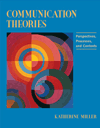
|  |
Feature Summary- Strong foundational chapters (1-5) help _students understand the scope and nature of learning about theory both generally and within the field of communication studies. Coverage is provided on the definition of communication, the nature of theory and metatheoretical considerations, and the three major theoretical perspectives of post-positivist, interpretive, and critical perspectives, providing a framework for understanding theory.
- "Spotlight on the Theorist" boxes found throughout the text provide commentary from key theorists about their work.
- Organizing Framework: Parts II (Processes) and III (Contexts) provide an organizing framework to help students see the relevance and "big picture" of how the different theories fit together.
- Current research and an extensive list of references provide material for further research for the student of communication theory.
- More selective coverage of theories with more depth of coverage than competing texts provide a better teaching tool for a deeper understanding of how to examine and critique communication theories.
- Comparison and Commentary sections follow each theory chapter to further critique and compare the theories within the chapter, helping the student see how they relate to each other.
- End-of-chapter pedagogy: Key terms and discussion questions aid students in checking their comprehension of each chapter.
|
|
|